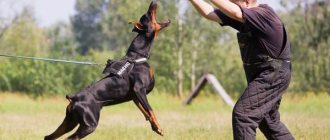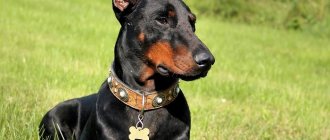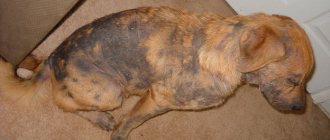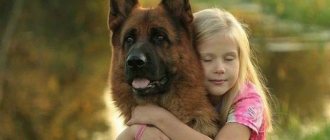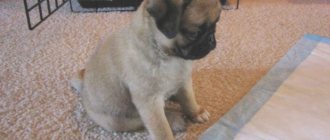A beautiful dog with even and straight ears is a real pride of the owner. Often, erect ears are considered the main sign of the breed of a tailed pet. However, they cannot always stand up on their own when they reach a certain age; they may remain hanging.
If the type of ears and their condition are not important to the owner, then he often does not pay attention to this defect, but what should those whose dogs take part in competitions and exhibitions do? In this case, you can try to install the ears yourself, but it’s still worth considering important features first.
Do I need to crop my ears?
Ear cropping is a surgical procedure during which part of the dog's ear is removed . After the procedure, the veterinarian who performed it creates an erect appearance for the ear.
Ear cropping is a process that depends on the wishes of the owner. The operation has no contraindications, and there are almost never complications after it. At the same time, you can easily leave the dog with its natural ear shape.
It all depends on what goals you are pursuing when purchasing a dog . If you need her as a loyal friend, then you can do without docking.
If the dog is raised for official purposes, you need to remember that the dog will be more comfortable with cropped ears and tail.
Also, participation in international exhibitions does not allow docking of parts of the dog’s body.
Pros and cons
The opinions of dog handlers and breeders have been divided regarding this procedure for a long time..
Some argue that the Doberman's natural appearance - long ears and tail - is acceptable. The latter are inclined to think that the dog will be more comfortable with docked ones, plus this adds more aesthetics to the animal’s exterior.
Here are all the pros and cons regarding cropping Doberman ears.
Advantages:
- Ear cropping does not in any way affect the development, health or life expectancy of the Doberman;
- Gives the dog's head an aesthetically pleasing appearance;
- In hunting and dog fighting it will help to avoid additional injuries;
- To some extent reduce the risk of ear diseases;
- The Doberman will take on a more familiar appearance.
Flaws:
- Inadmissibility to participate in international exhibitions;
- Complex process of ear placement;
- It will be more difficult for the animal to express its emotions, because with the help of its ears it can also convey its mood;
- The procedure is only for the dog to meet human standards of Doberman beauty.
“It is a myth that the tail and ears interfere with the Doberman in everyday life. If a dog is born with them, it means that he will fully learn to use them, because these are parts of his body. But nature doesn’t give anything for nothing: a tail, for example, is needed to control the body in a jump, and the fact that a Doberman can cope with this without it does not mean that it does not need it. Same with the ears. Here only the owner decides how he likes to see his pet.”
Is it necessary to dock the tail and why?
A similar situation exists with tail docking. Dobermans with a short tail are more common than those with a long one .
Most of all breeders carry out this procedure with puppies, so it is incredibly difficult to meet long-tailed Dobermans.
There is one catch associated with this - due to docking, the genetic shape of the tail is not fixed in any way in the standard.
Therefore, it is impossible to determine which tail of an undocked dog is suitable and which is defective. A puppy can be born with a completely different tail - bent, twisted, raised up.
This is another reason why it is better for a Doberman to have this part of the body docked, because you will always be at risk when participating in exhibitions or competitions.
NOTE!
The tail must be docked if the dog develops in hunting and fighting activities.
Tail docking is a procedure that also depends on the wishes of the owner, but the shortened appearance of the tail is the most acceptable feature for a Doberman.
At what age should ears go up?
All newborn puppies, regardless of breed, are characterized by small ears that are pressed tightly to the skull. During this period, they are shapeless, so it is impossible to accurately determine their position (hanging or standing).
With age, the cartilage tissue becomes denser, and as a result, the ears begin to rise. During this period, the differences between straight-eared and lop-eared dogs become most obvious.
Puppies usually develop ears between 2 and 5 months of age. But still, the exact age depends on the specific breed of dog:
- In Yorkshire Terriers, ear lifting is observed as early as 2 months;
- For a shepherd puppy - at 4-5 months;
- For larger breeds – 5-6 months.
Advantages and disadvantages
This aspect of the breed was also the subject of controversy after Germany banned Doberman tail docking.
As usual, two sides emerged, opponents and supporters of this procedure.
Pros of tail docking:
- The dog's injury rate is reduced;
- Pleasant and familiar aesthetic appearance;
- Avoiding disqualification at some shows.
Cons of tail docking:
- It will be more difficult for the dog to socialize among other relatives;
- Expressing emotions with a tail is much easier;
- Participation in international exhibitions is allowed.
At what age is the procedure performed?
The docking age is selected very responsibly, because if it is not calculated correctly, the dog can be crippled. The time at which ears and tails are docked varies.
Ear cropping usually occurs 5-10 days after birth . At this age, the puppy will undergo surgery without anesthesia, because the nerve endings have not yet formed in the cartilage.
But, if you are late or simply did not have time to make a decision, then you have a second try. This procedure can be performed when the dog is 2-3 months old. In this case, the operation must be performed under anesthesia.
Cupping cannot be done while the dog is changing teeth..
A Doberman puppy's tail needs to be docked in the first week of its life. This is also due to the fact that the cartilage has not yet had time to ossify and so the procedure will be painless for the puppy.
At most, the operation can be performed on the fifth day, but the third would be ideal. But even in this case, you have a second chance.
You can perform tail docking later until the dog is six months old..
But at this age, the tail vertebrae have already ossified, and in order for the procedure to take place correctly and without harm to the dog, you need to seek help from an experienced veterinarian.
When should ears be cropped?
Remember one simple rule: the earlier the tail and ears are docked, the easier the animal will tolerate this procedure. According to the recommendations of dog handlers and veterinarians, the optimal age of a puppy for such an operation is considered to be the life period from 3 to 10 days from birth. In puppies, blood circulation is slower, and the healing process, on the contrary, occurs much faster. Cupping is also allowed at 5–8 weeks of age. However, the operation is already performed under anesthesia so as not to injure the animal.
It is not recommended to put ears on a Doberman during the period of teeth change, since at this time many vitamins and minerals are spent on the formation of the animal’s skeleton and jaw.
Preparing for surgery
If the operation is performed when the puppy is very young, that is, less than a week has passed since birth, then anesthesia is not needed. Blood circulation in these parts of the body is still slow and therefore they will heal quickly.
If the procedure is carried out later, when the dog has already grown up, then anesthesia cannot be avoided.
In this case, the puppy must be prepared:
- The Doberman must be healthy the day before surgery. There should be no lethargy or weakness;
- The dog should not have worms and fleas, i.e. it must be treated for these parasites;
- The dog should not be fed during the day;
- She should not drink or eat for two hours before surgery.
How it happens in stages
There are several steps in this procedure:
- The doctor administers anesthesia and examines the dog's head and ears;
- Marks excess skin, guided by the principle of cutting off 2/5 of the auricle. This proportion also depends on the size of the puppy's head;
- The doctor attaches a stencil and trims away excess skin;
- Sews up the wound without piercing the cartilage.
The ear cropping procedure cannot be done at the same time as tail trimming . At least 7 days should pass between them, and the ears should be trimmed earlier.
Ear placement
When trimming a Doberman's ears, your veterinarian may use three types of clip molds:
- straight;
- curved;
- zigzag.
After processing the edges, it is necessary to ensure that the cropped ears do not dangle, but stand straight. To do this, immediately after the operation they are wrapped in a bandage. It is connected to each other in such a way that the ears point upward. A cotton swab or foam rubber rim will help to strengthen the structure.
In order for the tissue to heal faster, it is necessary to step back from the head and the seam at a distance of 1-2 cm. In this case, it is possible to treat the scar daily and identify the occurrence of side effects. In addition, in the fresh air, all wounds heal faster than under a bandage.
How to position the ears
To ensure that the ear does not fall off after the operation, but retains its shape, the puppy undergoes a gluing operation.:
- Lift your pet's ear, take a wide strip of adhesive tape and stick it from the cut edge on the outside of the ear. During this procedure, it is important to slightly stretch the ear tissue and glue it in short strips for better fastening. Be careful so that your dog does not develop swelling in the future;
- Leave an untouched space of 2-2.5 cm at the top and bottom of the ear. This will make it more convenient to check for swelling;
- Install the bridge between the ears using adhesive tape. Remember that a dog can walk with this design for two weeks;
- If the ears begin to tilt in different directions, the structure should be rebuilt.
There are also other types of designs for setting the ears:
- Straight;
- Curved;
- Zigzag.
You need to know that ears are placed immediately after surgery. You must first process the edges and then wrap them with adhesive tape.
IMPORTANT!
The ears should always point upward. To prevent them from falling, you can use a cotton swab or a foam rubber band.
Also, a deviation of 2-2.5 cm from the seam will allow you to treat the cut every day, as well as monitor its condition . In the fresh air, all wounds heal much faster than in the absence of oxygen.
How to install Doberman ears at home?
The Doberman's ears need to be set after cropping. While the puppy has not come out of anesthesia and is lying calmly on the table, you can perform the “garter”.
How to put on a Doberman's ears after cropping so that they meet the standards? To do this, you need to take a four-centimeter wide patch and apply it on both sides of the ear, without covering the newly cut edge. The sticky surface of the patch treated with ether will stick to the ear more firmly. Then you need to make a bridge between the ears from a centimeter-wide plaster so that they stand straight up and forward, as they should be.
In the process of putting on the Doberman's ears after cropping, remember that the bridge should be at a height of half the length of the ear, without covering the postoperative incision, then you can treat it twice a day, and healing proceeds much faster in the air. For treatment, you can use furatsilin ointment (“Furacin”) or “Panalogue,” and also powder the ear at the base with “BFI.” If folds appear, they should be carefully straightened out, otherwise the ears may subsequently stand up incorrectly.
We invite you to read: Features of giving birth to cats at home
How to care for Doberman's cropped ears after surgery? After a week, the thread is removed; if the edges were sutured correctly (with a continuous seam), then you just need to cut the knot at the base of the ear and pull it out.
This method is especially effective when the ears are erect, but one of them is a little soft. The idea is to benefit the weak ear at the expense of the strong one. Sometimes it is enough to simply connect the ears together with a strip of Plaster 2.5 cm wide. With this method, the dog can freely move its ears, catching the sound, and strain them, but where there are several playful puppies, it is better not to use it.
If the dog is under the control of the owner or there are adult dogs in the house, it is ideal. Use this method if the puppy's ears first stood up and then suddenly drooped. You should not pull the ears together too tightly, otherwise it is better to cut the patch in the middle and connect it again, but more loosely.
The entire operation lasts no more than half an hour.
How much does the procedure cost?
Remember that the younger the Doberman, the less money you will have to pay for the ear cropping procedure.
Before the age of one month, it will cost 500-1000 rubles to install drooping ears on a puppy, and docking surgery for dogs up to six months costs 2000-3000 rubles.
If you are not comfortable taking your puppy to a veterinary center, you can call a doctor at home, but in this case you will have to pay an additional 1000 rubles.
Also remember that the final price of the operation is also influenced by the presence/absence of anesthesia, the qualifications of the doctor and the prestige of the clinic.
It happens that docking is also performed on adult dogs. In this case, the price will be the highest, because the dog may experience complications during wound healing.
Owners of adult Dobermans pay 3,000-5,000 thousand rubles for the procedure..
How to fix a clogged ear A clogged ear usually forms in the lower half of the ear. This happens when the ear does not stand up immediately, and the strengthening of the cartilage is delayed for some reason (the reasons are discussed in the section Correction. Ears in dogs).
If the ear tries to stand up, but in the lower half of the ear there are areas of very weak cartilage, then in this place the ear bends and seems to break under its own weight. At the bend site, blood circulation is disrupted and a crease strip is formed.
When palpated, it seems that there is no cartilage in this place under the skin. The situation is even worse when a fold, a thickening of the cartilage, begins to form below the crease itself.
There is a situation when urgent ear reattachment is required: the ear has almost risen, but a barely noticeable fold has formed on the auricle. A crease or, even worse, a scar may form here. It is important not to miss the moment. Read more: How to recognize the appearance of a crease or scar in the ear in time
To avoid creases and especially the formation of folds, it is necessary to glue a slowly rising ear if its weak point is below the upper third of the ear.
The sooner you start restoring a dog’s cramp, the sooner you will correct it.
In a growing puppy, this will happen quickly - within 1-2 months. For a teenager it takes a little longer. In an adult dog - on average 4-6 months.
Case study: German Shepherd, female, 4 years old.
This is my own dog. Her mother, grandmother and other relatives were very happy with their ears. Therefore, until 6 months I was not worried that one ear was not standing up well, and I did not notice how a crease had formed in it. I glued it, massaged it, and used proprietary fertilizers for several years. It got better - but not for the exhibition... Zora was already 4 years old when I came to Vision. The program I created for Zora's ears was a test to see if Vision products were really as effective as they said. — The soft parts of the ears began to get stronger before our eyes. The hall became overgrown in more than 4 months. The ligaments of the hind limbs have become much stronger. Since then, these schemes have been successfully used by Vision dog trainers in various cities for dogs of different breeds.
The most important thing: To restore blood circulation and cartilage tissue in a fractured ear, a complex of several products is needed (at least 4 at a time).
These are 3 mandatory products: Antiox+, Pax+ forte, Mega. They must be supplemented with one product from the following products: Senior, Junior Neo or Junior Bee Weiss+. In many cases, cartilage will recover faster if Sveltform+ is added or included instead of Senior or Junior.
The choice, as well as the dosage, depends on the specific situation with your dog and can be clarified during consultation.
The plants that make up Antioxa+, Paxa+ forte and Sveltforma+ help improve blood circulation, including blood microcirculation, and thereby restore cartilage tissue in the fracture. The components of these plants contribute to the formation of high-quality, strong, mature collagen and the stabilization of collagen molecules. In addition, the plants contained in these products are able to accumulate organic silicon, which is necessary for the synthesis of cartilage tissue, including elastic tissue, that is, such as in the ear. But in some cases, Junior Bee Big (for a growing dog) or EnjoyNT will also be useful as the richest sources of organic silicon (bamboo extract). The latter is very effective for weak ligaments or problems with the limbs and does not give side effects, unlike many chondroprotectors.
An ear with a crease must be glued back.
And keep the glue on for a few more weeks after the ear begins to stand on its own. Although the place of the crease is visible to the eye, feel the auricle. This way you will accurately determine not only the location of the crease, but also its length and width. Pinching the ear from the inside and outside with the tips of two fingers, determine the weak point. When there is a crease, it is either a strip along which the ear bends, or a rather large spot. It is enough to pinch this spot or strip on both sides with two fingers and strengthen it for a minute, and you will see that the ear is standing.
The crease area must be glued. How to do this is described in the section How to glue ears.
Warning! When you change the “patch” on your ear, and suddenly you see that the ear is standing - hurray!!! - resist the desire to admire this delightful sight.
Tape the ear again. The cartilage at the fracture site is initially still very weak and will not withstand the load. After a while, the ear will begin to droop again, and you will fall back in your efforts.
As your ear gets stronger, you can reduce the size of the patch. But after the ear begins to rise, it should be on it for at least another month. Of course, all this time the dog must receive all the Vision supplements it needs.
Copies of the ear adjustment pages (from my old site gloria.wellnet.me) have been posted on many sites.
Moreover, in some places the names of “Vision” supplements are replaced with the words “vitamins and mineral supplements,” and in others the names of other drugs are substituted. A logical question arises: Can other vitamin and mineral supplements restore cartilage in a fracture, especially in an adult dog? Or try to create your own supplement using Vision formulas?The answer is simple: Vision's formulas are open, they contain only proven and useful ingredients, so copies will bring certain benefits to the body, but the result cannot be repeated. To do this, you need to have the unique technologies of the French pharmaceutical concern Arkopharma.
Formulas can be copied, but efficiency cannot. Therefore, I want to emphasize once again that it is not the glue that restores the ear cartilage in the crease, but Vision products.
This is a proven and, as far as my almost half a century of canine experience allows me to judge, the only reliable way to fix an ear with a crease. To do this, it is enough to get an individual consultation and then purchase the recommended products through our website (Buy).


